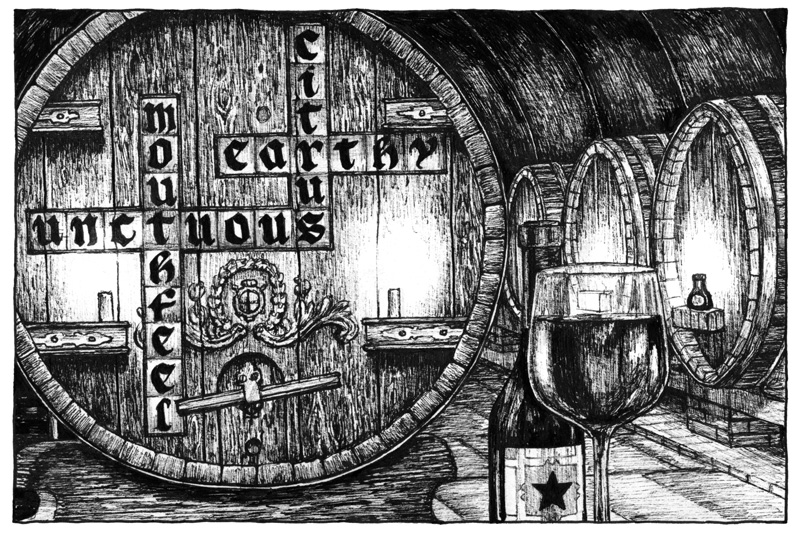By Mugroso
Illustration by Ezra Butt
When was the last time you swallowed pencil shavings? Sucked on a wet horse blanket? Savored crushed violets?
I’m pretty sure you can say with surety that any of these treats is an unlikely experience in your recent past. Or maybe even as a child. But as an adult (over the age of 21, dear OLCC), chances are, if you are a wine lover you have done just that…whether you knew it or not.
One of the things I love about a great glass of wine is the delightful nuance and artistry of the juice. Same grape variety, different soil type, different climate, different winemaker results in…difference. Some wines are similar, even very similar, but among any set of people drinking the same wine you will find difference in what seemed to be a shared experience. How we describe that difference often is in the words we choose to depict the mouth-feel, the essence in the nose, the flavor on the palate, and the finish once the wine exits and our combined senses are left to savor the experience.
This is the wordplay of wine. It can be fun, fanciful, and at times downright silly. But the power of wine descriptors, among both the uninitiated and the snobby, is transcendent. Share a bottle with a couple of friends and, after a couple sips, confidently say, “Wow, are you picking up that allspice in the back of the palate?” Whether your friends could discern allspice from cinnamon or nutmeg in the spice rack, one, if not all, they will reply: “Oh, yeah. Amazing. You called it!”
Wine wordplay. It’s like playing Scrabble in your mouth. Take a sip, look at the letter blocks on the rack in your head, and let the juicy experience form words to lay on the board. Triple word score for licorice!
Scientific American, among other scholarly and not-so-scholarly journals, has reported that there are—for simple categorization purposes—three types of tasters…in general, not just for wine. The non-taster (poor slugs), the medium-taster (typical, normal blokes), and *trumpets sound on high* super-tasters.
Super-tasters are blessed with a proliferation of Fungiform papillae. No, not some heinous sexually transmitted disease or even halitosis extraordinaire. I’m talking about your taste buds. Super-tasters quite simply have more of these than the rest of us. These same scientists suggest that some 25 percent of us have this “gift.” (However, if you don’t like broccoli and you’re a super-taster…well, you might not always consider it a gift.)
I met my first super-taster one summer’s eve in 1992, at a blind tasting of pinot noir at my pal the Big O’s house in California. The tasters were the usual suspects: the professor and his darling spouse who usually spilled at least one glass per session; the lawyer flying solo; the pinche cabrone; and me, and I might have had a date. But I remember the wine just fine.
We were working our way through a nice set of talented and fairly aged California pinots, and in those days we would make notes about the bouquet, the taste, the finish, how the wines changed after being open—and we would rank the wines. The professor gleaned rankings from every taster and asked what it was about each wine that we personally liked (why we ranked it highly) or did not like. In so doing, inevitably some of those wordplay descriptors would emerge.
It was that night I realized my friend, the Big O (short for the Big Omniscient, not some sexual innuendo) was a super-taster. (Well, I hadn’t read Scientific American yet, so I didn’t know that was what the term for him was, and all. But it’s not like the Big O is an unsatisfying moniker, right? Leo Daedalus would kill to be called the Big O!)
During the review of the wines, he described one as “nasturtiums.” The blank stares spoke for themselves. We all knew what nasturtiums were: a rather lovely flowering landscape plant of the Tropaeolum family, whose name means quite literally “nose-twister” or “nose-tweaker.” A relative of the cabbage family, nasturtiums are so called because they produce an oil, the essence of which is much like that of watercress. Even if we knew all of that, which none of us did at the time, I’m pretty sure watercress didn’t come up in the conversation.
The O’s nose knew something we didn’t. Something that was amusing, and even a little stupefying.
Up next, he came forward with a more commonplace descriptor, especially for the many of us Pac-Northwesters that migrated here from the vastness of the Midwest flyover states. He hit us with “canned asparagus.” It was one of those now-you-don’t-smell-it, now-you-do moments, when the power of suggestion won over everyone at the table. Yep—canned asparagus, alright!
In the Midwest a couple generations ago, fresh vegetables were non-existent in the winter (which equates roughly to half the year or more from a growing season standpoint). Vegetables came frozen or canned. We ate both styles at my house, but the canned asparagus was the most memorable. Brined asparagus pieces, mostly stalks as I recall, warmed lovingly by Mom and offered up in a Melmac serving bowl for our dining pleasure, they were fucking terrifying to a child, reminding me of the cigar butts my Grandpa Pete chewed then spit into the big living room ashtray. I never drank that wine again.
Here’s a few wine wordplay descriptors I’ve come to enjoy over the years, with my personal interpretation of their meaning/intent, understanding that I do not always comprehend why I would want to drink a fruit juice with something that tasted like *that in the bottle? Perhaps it is my love of words that overrides my Fungiform papillae? Cheers!
Pencil shavings. Anyone who emptied the pencil sharpener for your favorite grade-school teacher knows that smell…which prompts one to imagine drinking wine with your third-grade teacher (Mrs. Hoffman, for example, who you loved with all your heart and whose house you would sneak into to watch her sleep at night when you were nine).
Eucalyptus. A powerful aroma in wine, especially if a koala has been urinating down the trunk for a week. You know they don’t move around much.
Coffee. Black, please. The next morning, after a lot of wine.
*Horse blankets. A subset of the “barnyard” section of wine wordplay. When you’re galloping across the pampas on your way to a nice glass of Mendoza malbec—bueno —wet horse blankets is a welcome descriptor. When it conjures memories of the smell emanating from those fly-infested horses that we were offered to ride to the waterfall near Puerto Vallarta, no bueno.
Crushed violets. I cannot get right with someone who is mean to violets. Pick on a flower your own size, like the corpse flower at the U.S. Botanical Gardens. Now that is something you don’t want showing up in your wine bouquet.
Butter. Over used and common, the Big O taught me that it is not butter we smell, but diacetyl, the chemical that gives butter its scent and the same crap they put on the popcorn at the cineplex. (There’s even a syndrome called Diacetyl Lung. WTF?)
Earth. Can I get some worms and a coffin to go with that wine?
Charcoal. I prefer my charcoal flavor on my steak with a glass of wine, not in my wine.
Cigar box. My grandpa chewed, and occasionally smoked, cheap-ass Roi-Tan cigars. (See “canned asparagus” discussion in column above for unfortunate mental image.)
Flabby/fleshy. Tonight’s guest winemaker—Jeffrey Dahmer!
Unctuous. Oily? Maybe with red wine vinegar. I once heard on the radio one day a side effects disclaimer for a men’s pharmaceutical that included an oily discharge. Ick. Not in my wine!
Gamey. The ripe fleshy smell from a deceased wild animal. In the Midwest, this includes squirrel.
Leather. We all know the smell of leather: a saddle, a baseball glove, that fringe leather jacket our editor-in-chief, Ross Blanchard, still wears in public because he thinks it’s hip. Just so it’s not the leather the Conquistadors wore while raping and pillaging in the hot, humid, tropical southern hemisphere Americas. (See “gamey” above for tasting notes.)
____________________________________________________________________
Oregonington Selections of the Month:
2011 Soter Mineral Springs Ranch Pinot Noir, $55
The 2011 Mineral Springs Ranch Pinot Noir from acclaimed winemaker Tony Soter shows a bright ruby hue and an opulent nose. This aromatic showcase suggests cranberry, blackberry, rhubarb, spice, with a hint of black pepper and sandalwood. It is a young wine that evolves in the glass—on the palate it unfolds layers of fruit backed with balanced and smoothly refined tannins that offer a long finish. This wine is drinking well now but also will reward patience in the cellar. One of the best offerings from the fickle 2011 vintage.
Think crushed violets.
2009 Ribera Vineyards Confluence, $22
From Ribera’s close-in yet off-the-beaten-path West Linn estate comes this beautiful Red Mountain AVA American GSM (grenache/syrah/mourvedre) with a healthy addition of counoise. A lovely blend, rich and opulent in color with dark fruit essence of blackberry and bing cherry, the flavor is tinged with black pepper spiciness and cocoa. Firm yet supple tannins and good acidity give Confluence great length in the mouth. It had a small production, with only137 cases produced. Open weekends, come on down to West Linn and give Molly and Darrel Roby’s little slice of heaven a try.
Think leather—the good kind.

